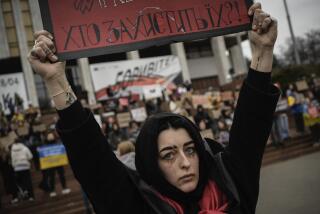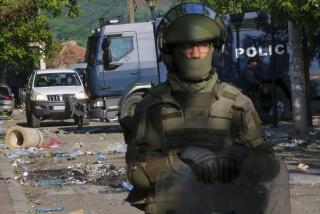NEWS ANALYSIS : Attack Shows NATO Has Bite to Back Up Its Bark : Bosnia: Serbian forces may recoil from punishment rather than risk more Western intervention.
- Share via
VIENNA — With its first resort to force after almost two years of empty threats and toothless directives, NATO has sent a message to Bosnia’s warring factions that there is military muscle behind alliance warnings and a price to pay for flouting its edicts.
By striking out at Bosnian Serb warplanes blatantly violating a U.N. “no-fly” order, the 16-nation alliance took an easy, unassailable shot at Serb nationalist rebels with clear enforcement authorization from the Security Council, which even Serb-allied Russia had endorsed.
Although the first reaction of the targeted Bosnian Serb forces was to escalate bombardment of the northern city of Tuzla, there were signs that Serbian forces may recoil from the punishment rather than retaliate and risk further Western intervention.
Bosnian Serb military and political leaders responded with contradictory expressions of bluster and restraint, hinting at disarray among the rebel forces that until Monday had encountered no serious Western deterrence to their deadly land grab.
For almost two years, Western diplomats and other observers of the conflict in the former Yugoslav federation have argued whether the use of force against Serb nationalist aggression would break rebel resolve to carve a Greater Serbia out of ethnically diverse communities or spark angry retaliation and a wider Balkans war.
After Monday’s action to enforce the “no-fly” zone, the North Atlantic Treaty Organization and the United Nations may see their peacemaking initiatives heeded with more respect.
The U.N. Protection Force in the Balkans has set a March 7 deadline for opening an airport in Tuzla to humanitarian relief flights--an objective that looked, until Monday, to have little chance of achievement.
But Bosnian Serb forces now have to reckon with the possibility of forceful retaliation, if they continue to block relief flights to the airport and pepper the U.N.-controlled runway with artillery fire.
Likewise, a U.N. plan for gradually imposing peace between Croats and Muslims in Central Bosnia appeared to get a boost from the NATO action. Fighting had continued unabated since the United Nations announced last week that it would seek to extend a tense peace imposed on Sarajevo to other areas of the republic. But the guns were reported to have fallen silent after word of NATO’s first forceful intervention in the nearly 3-year-old Balkans war.
Bosnian Serbs last week had scored a major diplomatic coup by evading punitive NATO air strikes, despite flagrant violations of an alliance order to pull heavy artillery out of firing range of Sarajevo.
After a heavy artillery shell killed 68 civilians at a crowded open-air market on Feb. 5, NATO ordered all tanks, howitzers and rocket-launchers out of a 12-mile zone around the Bosnian capital.
As the Feb. 21 deadline approached, U.N. Protection Force officers and Russian politicians bargained for restraint on NATO’s part, claiming an end to the siege of Sarajevo had been achieved by the threat of force alone.
But hundreds of Serbian weapons remained deployed within the exclusion zone, and increasing instances of mortar fire and artillery movements in recent days have made clear that NATO had foregone its opportunity to show the rebels it has the confidence and authority to use force.
NATO last summer threatened to strike at the Serbs, if they continued their slow strangulation of the Bosnian capital, and an earlier warning of impending air strikes to enforce a U.N.-mediated partitioning of the republic had also gone unfulfilled, leading the rebels to conclude NATO was a paper tiger.
The “no-fly” zone proclaimed in October, 1992, was the most brazenly violated NATO order and, therefore, a wise choice for enforcement by the alliance that needed to restore the notion that credible force stands behind its threats.
Russian intervention on behalf of traditional Serbian allies spared the rebels NATO air strikes last week; the Serbs appeared emboldened enough by that support to step up attacks on other government targets like the Tuzla airport, the besieged Maglaj region and the volatile Muslim enclave around Bihac.
NATO’s first-ever shots fired in anger also sent a warning to the Kremlin that it will not be allowed to protect Serbian rebels from Western punishment if they continue to violate U.N. resolutions and thwart the international community’s attempts to restore peace.
The Kremlin’s response to NATO’s downing of the four fixed-wing Galeb aircraft suggested that it had beat a face-saving retreat to join Western allies in their claims of resolve to halt the Balkan bloodshed. “If the Serbs did this, I see no justification,” Russian Defense Minister Pavel S. Grachev said of the reported “no-fly” zone violations.
Although Russia has warned that military intervention could worsen the war, there were no immediate protests of the NATO action from Russian authorities in positions of power.
The commander of U.N. forces in Bosnia, British Lt. Gen. Michael Rose, also reacted with words of support for NATO, despite unmasked opposition to the air strikes that were threatened last week. “It shows NATO has teeth,” Rose said of the NATO plane downings. “It shows that if people are in flagrant violation of agreements, they’ll suffer the consequences.”
Rose’s reputation has been riding on the deteriorating cease-fire proclaimed in Sarajevo prior to the NATO deadline for moving heavy guns out of firing range of the capital. At Rose’s insistence, NATO withheld enforcement action only to see a steady escalation of hostile fire from remaining Serbian positions.
Even Bosnian Serb leaders refrained from belligerent statements after the NATO action. Nationalist chieftain Radovan Karadzic, en route from Belgrade to Moscow for consultation with Slav Orthodox allies, said NATO reports that Bosnian Serbs had violated the “no-fly” zone were being investigated.
“We simply do not know the truth yet. We will know soon what happened, whether it was a Croat or Serb flight or some training or combat flight,” an uncharacteristically contrite Karadzic told reporters at Belgrade airport.
His wait-and-see approach contrasted sharply with the flat denial issued by the Bosnian Serb army, which claimed Serbian aircraft had “never breached the ‘no-fly’ zone since it came into force in October, 1992.”
U.N. sources say at least 1,000 violations have been recorded, most of them by the Bosnian Serbs, who have at least 30 fixed-wing planes and 20 attack helicopters, in contrast with a handful of helicopter gunships held by the Croats and no combat aircraft among the Muslim-led government forces.
Times special correspondents Laura Silber in Belgrade, Yugoslavia, and Danica Kirka in Zagreb, Croatia, contributed to this report.
The ‘No-Fly’ Zone
A look at the area over Bosnia declared off limits:
* Background: The United States declared a “no-fly” zone over all of Bosnia-Herzegovina, aimed primarily at Bosnian Serbs, in October, 1992. On April 12, 1993, NATO planes began Operation Deny Flight, intended to enforce the declaration, the first instance of the North Atlantic Treaty Organization flexing its military muscles beyond the territory of member states.
* Execution: Warplanes from aircraft carriers in the Adriatic Sea and NATO bases in Italy fly over Bosnia on daily patrols with the help of AWACS surveillance planes operating over Hungary to the north.
* Past violations: Though frequent violations of the “no-fly” zone have been reported, most often by helicopters said to be transporting troops or weaponry, there were no known instances of NATO aircraft trying to shoot down violators before Monday’s incident. Mountainous terrain often makes spotting and confirming such violations difficult.
* Planes: Bosnian Serbs have older-model fixed-wing warplanes and helicopters at Banja Luka, their stronghold in northwest Bosnia. The Muslim-led government and Bosnian Croats are believed to have only a few helicopters used for transport.
Source: Times wire reports
More to Read
Sign up for Essential California
The most important California stories and recommendations in your inbox every morning.
You may occasionally receive promotional content from the Los Angeles Times.














